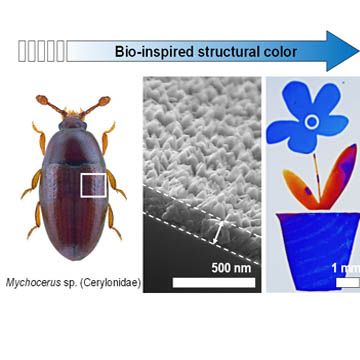
Biomimetic structural colors are fabricated with a new technique involving quasi-ordered zinc oxide nanostructures. [Image: American Chemical Society]
Inspired by iridescent beetle shells, Korean researchers have developed and demonstrated a low-cost hydrothermal growth technique for fabricating zinc oxide (ZnO) nanostructures that act as structural colors and are tunable post-fabrication (ACS Appl. Mater. Interfaces, doi: 10.1021/acsami.6b15892). Structural colors are intriguing to paint and cosmetic companies, and fiber, sensor and microelectrode manufacturers, because unlike pigment-based colors, structural colors don’t degrade or bleach out in the presence of light. Additionally, the colors can change depending on the viewing angle.
One hurdle to the wide-spread implementation of structural colors is cost—nanostructures in structural colors need to be precisely fabricated with high reproducibility, which makes production expensive in real-world, large-area applications. The researchers say they can create biomimetic structural colors faster and at a lower cost than traditional fabrication methods, since their technique allows them to create multiple structural colors simultaneously on a single substrate at a relatively low temperature. Further, the colors can be tuned even after they’ve been affixed—an option that doesn’t exist with current structural-color fabrication methods.
Quasi-ordered scattering
Quasi-ordered scattering is a type of structural color pattern—it occurs in iridescent beetle shells when uniformly sized and spaced nanostructures within the shell are illuminated and reflect back blue, green and purple. The color reflected back depends on the spacing and size of the nanostructures, as well as the viewing angle. Team lead Geunbae Lim from the Pohang University of Science and Technology, along with colleagues Geon Hwee Kim and Taechang An, used the beetle’s quasi-ordered scattering motif as inspiration for their biomimetic structural-color fabrication method.
To create the nanostructures, the team started with a silicon wafer base and spin coated a seed layer of ZnO on its surface. Next, they used a hydrothermal growth method to build ZnO nanostructures on the seed layer. This involved dipping the seed-coated wafer in a 40 to 80 °C solution of zinc ions (Zn2+). To precipitate the Zn2+ out of solution and onto the wafer in nanostructure form, the researchers raised the pH of the solution above 10.
ZnO nanostructure demonstration
Lim and his colleagues then used a flower-shaped silicon wafer with a seed layer of ZnO for a fabrication demonstration. With scanning electron microscopy, the researchers observed the growth of ZnO nanostructures on the silicon wafer for four minutes. They found that the nanostructures’ thickness and diameters grew the longer the wafer remained in the Zn2+ solution, resulting in structural-color change from blue to red. (The nanostructure layer thickness had an average growth rate of 43-nm per minute; the diameter of the nanostructures had an average growth rate of 20-nm per minute.) In addition, they saw that the nanostructures maintained unimodal distribution of size and spacing, consistent with the quasi-ordered scattering motif.
The team also found that it could create different structural colors and shapes on the wafers with a few modifications to the hydrothermal process. Using masking tape or standard MEMS lithography techniques, the researchers created patterns on the ZnO seed layer before hydrothermal growth. They could also control the shapes on the wafer after fabrication by using diluted hydrochloric acid to etch away unwanted structures after hydrothermal growth.
Bottom-up and top-down
Lim and his team say their technique is the first to combine bottom-up (growing nanostructures on a substrate) and top-down (etching patterns and shapes onto nanostructures) approaches to fabricating structural colors. “This technique,” the researchers write, is capable of large-area fabrication, allows for flexible fabrication and modification of structural colors, and features reasonable fabrications costs, unlike similar previously published processes.” And they expect the method “to be applicable to several fields, including the fabrication of microelectrodes by combining this method with MEMS processing, sensors and antitampering tags.”
